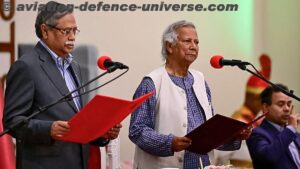Visit may also counter Chinese influence
By JK Verma
New Delhi. 14 May 2018. Prime Minister Narendra Modi understands the importance of active and assertive foreign policy; hence he made successful tours of several countries of the world including superpower like America as well as China which is trying hard to become a super power. He also comprehended that India must maintain friendly relations with all its immediate neighbours and propounded “neighbourhood first” policy. He invited all the South Asian Association for Regional Cooperation (SAARC) countries at his oath taking ceremony and on the next day he had bilateral talks with all the heads of state. The media projected it as a small SAARC summit. He also told scientists of Indian Space Research Organisation (ISRO) to build up an exclusive SAARC satellite.
The whirlwind tours of Modi achieved positive results and the Foreign Direct Investment (FDI) enhanced considerably, not only this few countries also agreed to transfer technology under present government’s ambitious ‘Make in India’ programme which will generate opportunities of massive employment.
India’s Western neighbour which has waged a low-intensity war against India was sidelined in international community and even United States suspended aid to Islamabad which was a big jolt to its economy.
China, which overtly shows that it wants to inculcate friendship with India but covertly instigates Pakistan to assist terrorism in India, is also encircling the country. Hence it is significant that Modi by its visits abroad inculcates multiple friends and in case of hostility with China they render direct or indirect assistance to New Delhi.
The present communist government of Nepal under Prime Minister K P Sharma Oli is considered to be pro-China while the statements and actions of Oli in his previous tenure were anti-India. Nonetheless this time Oli paid a three day official visit to India from April 6th, 2018 which was his first overseas visit after taking over as Prime Minister. After completion of his visit he mentioned that the visit was not only “significant” and “fruitful” but it also cleared apprehensions and misconceptions. The visit also restored mutual trust which was unfortunately worn-out. Nonetheless Indian policy planners also attach prodigious importance to Nepal hence Modi reached Kathmandu on May 11 on a two-day visit to further strengthen the relations between New Delhi and Kathmandu. The present visit indicates the importance New Delhi attaches to Kathmandu as it is the third visit of Modi after taking over in 2104 although it is his first visit after Oli took over as Prime Minister.
Indian policy planners have rightly assessed that Oli has emerged very powerful in his second term, as the present Left Alliance between Communist Party of Nepal (United Marxist-Leninist) and the Communist Party of Nepal (Maoists Centre) will occupy all important positions, nonetheless Oli will have to sort out the problem of Madhesis as well as he will have to make a balance between India and China. In his last term he tilted excessively in favour of China and signed a trade and transit agreement with China to counter India. He also promised to link Nepal and China through Rail link although not much headway was achieved on these projects but there is an acute pressure from pro-China and anti-India lobby to accelerate these projects. The analysts claim that Oli would renew China’s Budhi-Gandaki project and will try to strengthen connectivity with geographically difficult China with ulterior motive of finishing Nepal’s dependence on India.
Chinese investment is much more than India and the former has surplus foreign exchange which it invests in the infrastructure projects of neighbouring countries. Nepal is suffering with rampant poverty and paucity of basic infrastructure hence it is desperate to develop infrastructure. In 2014 China outpaced India and became the leading investor in the country. Again in 2017 Chinese firms pledged the investment of $ 8.3 billion while Indian firms committed $317 million only. Chinese tourists are visiting Nepal in large number and more Nepalese students are going to China for studies. Several Chinese language institutes have opened in Nepal.
Unfortunately Indian projects are delayed and although Prime Minister Modi in his first visit to Nepal in 2014 promised to complete the projects within targeted time but there is no marked improvement and most of Indian funded projects including hydropower project on the Mahakali River could not meet the targets.
China has adopted the strategy of investing in neighbouring countries with ulterior motive of encircling India. China invested in Pakistan and occupied Gwadar Port, same way Sri Lanka had to surrender Hambantota Port after signing a lease of 99 years. China invested formidable amount in Bangladesh and signed Free Trade Agreement (FTA) with Maldives. China has also taken one island in Maldives and likely to take one more island. First Beijing tried to invest in Afghanistan along with its all weather friend Pakistan but it could not work due to Islamabad’s sullied image in the country. Now both India and China would be working on joint projects in Afghanistan.
Oli won recently held elections on anti-India rhetoric as people of Nepal still remember the sufferings because of alleged blockade by India which began on 23 September, 2015. Anti-India lobby in Nepal alleges that India wants to dominate Nepal and it was the only country which objected the promulgation of its constitution in 2015. India baiters further allege that India insists on the formation of a separate state for Madhesis (people of Indian origin) but Nepal considers it as a security threat. Indian detractors also mention that Bharatiya Janata Party (BJP) also urges that Nepal should be a Hindu nation and should drop secular word from constitution which is not acceptable to Nepalese masses.
Modi in the current visit gave mythological references and emphasised more on old cultural and religious ties and people to people contact and about the development of “Ramayana Circuit” which would enhance religious tourism. He also announced Rs.100 crore packages to develop Janakpur which is birthplace of Hindu goddess Sita. Both prime ministers jointly inaugurated Janakpur-Ayodhya bus service which will link two important cities of “Ramayana Circuit”. Modi besides “Ramayana Circuit” also announced about the development of places associated with Buddha and Jain religions. It would enhance contact between nationals of both the countries and will accelerate tourism which will generate employment.
Modi also accentuated the promotion of tradition, trade, tourism, technology and transport. He also emphasised the importance of connecting India and Nepal through information technology, expressways, railways, waterways, airways etc. He assured that India will construct railway line between Raxaul and Kathmandu.
The far-sighted Nepalese understand that China has expansionist designs and Chinese companies not only charge more money but the rate of interest is also much higher. Chinese are building Pokhara Airport at the cost of USD 216 million however the estimated cost was USD 140 million only. Not only has this China forced the other countries to lease strategic places including ports to China. India being a democratic country it is easy to criticise India but it may not be that easy to criticise communist China.
Anti- India and pro-Chinese Nepalese were also able to organise few protests during the visit of Modi and demanded apology for 2015 economic blockade. However analysts claim that the protests were more against Nepalese government than against India. Besides demonstrations there were two bomb blasts, first explosion was near Indian Consulate at Biratnagar while the other was on April 29 in hydroelectricity project in Khandbari. Modi also laid foundation stone USD 1.5 billion hydro-electricity project.
On May 8, Nepal government has withdrawn Budhi Gandaki hydropower project which was given to a Chinese company by the previous government led by Prachanda in 2016. The contract was given without tender and now the present government will give the project after issue of global tender. It is a positive gesture by Oli government.
The basic purpose of Modi’s visit was to inculcate friendship with Nepal and clear the misunderstanding. India cannot compete China as for as investments are concerned hence Modi insisted more on people to people contact.
After the visit Modi tweeted that the visit was “historic” and “productive”. The joint statement reiterated to work together to strengthen the bilateral relations. Oli who is determined to develop Nepal will like to have close relationship with India which is the largest business partner of Nepal. Oli is not anti-India and he understands that 90 percent of Nepalese trade is with India and geographically India can assist easily than China.
India should chalk out a long term plan so that misconceptions generated in the minds of Nepalese masses are resolved. The misunderstanding include that India renders big-brotherly treatment to Nepal and security forces deployed on India-Nepal borders ill-treat Nepalese crossing the international borders. Nepalese are also worried about the rising trade deficit and inundation of Terai region because of dams made in Indian side. Indian tormentors are also against the recruitment of Nepalese citizens in Indian army. In nutshell Nepalese want to be treated on equal footing as Nepal is a sovereign state which is not a big deal. Indian bureaucracy as well as all Indians dealing with Nepal should try to clear the misunderstanding.
(Jai Kumar Verma is a Delhi-based strategic analyst and a retired senior intelligence officer. He is also member of United Services Institute of India and Institute for Defence Studies and Analyses.The views in the article are solely the author’s. He can be contacted at editor.adu@gmail.com)






























































































































